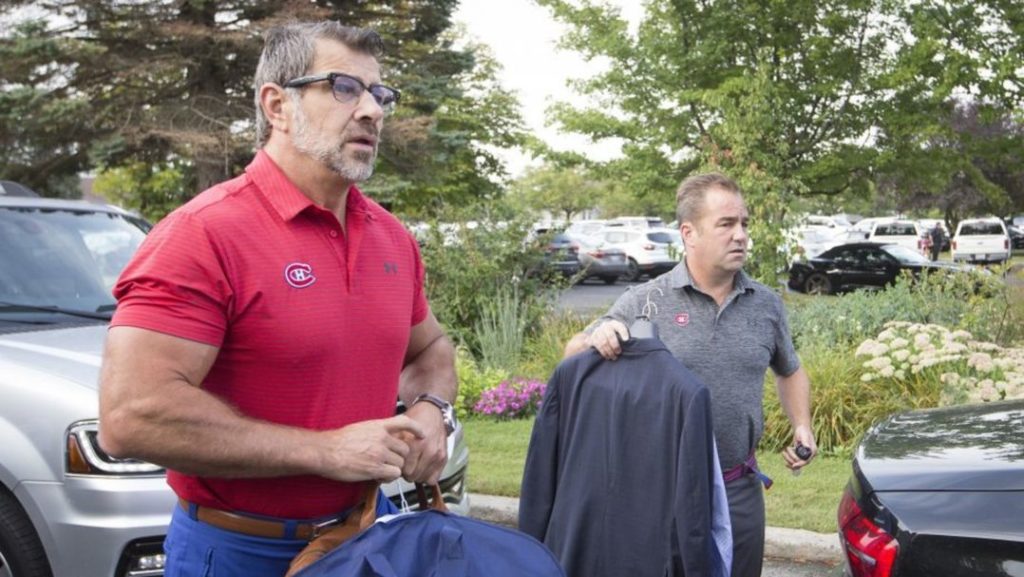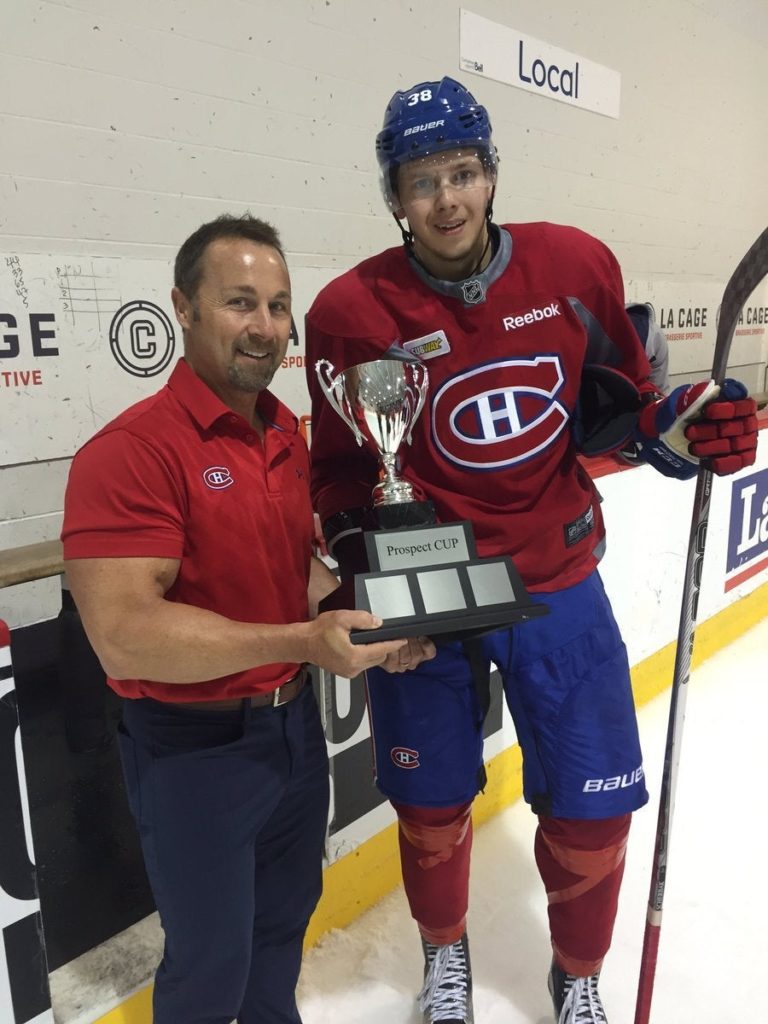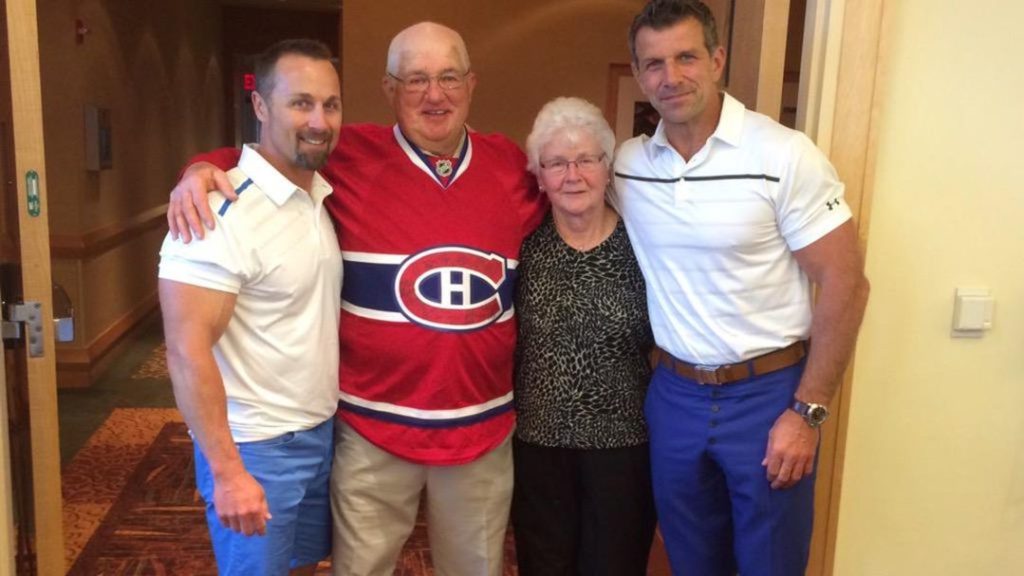Grant’s Slant Special Feature
October 4, 2019
By Grant McCagg
When you walk into a room during the summer with Marc Bergevin, Martin Lapointe and Trevor Timmins, you can’t help but wonder how you ended up at the gun show instead of a hockey meeting.
“They look like powerlifters,” said one longtime NHL scout who keep himself in pretty good shape himself. “They can point you to the beach…with a flexing bicep.”

While that’s not necessarily the norm yet in NHL circles among management types, with Bergevin’s pythons tending to stick out at the GM’s meetings, there has been a noticeable improvement in the overall fitness of NHL scouting staffs over the past 20 years.
Timmins was well ahead of the curve, and is considered a pioneer in that regard. Now in his early 50’s, he first started lifting weights in high school to get stronger for football. In his first year at Queens University, where he majored in phys ed, Timmins got heavily into bodybuilding, and he has never stopped. There were not many scouts with similar physiques when he first started scouting on a full-time basis with the Ottawa Senators in 1995.
“Trevor really was one of the first scouts to really take his fitness seriously,” said one amateur scout whose career started at the same time as Timmins.
“When I first started out, scouts used to go to the bars after game pretty much every night, and eat heavy meals. After a few years of that I found that I just couldn’t do it any more if I wanted to stay healthy and sharp.”
It hasn’t been a quick transition by any means. Getting together after a game for a few beers to kibbitz with like-minded people is, first and foremost, a fun thing to do, and a longstanding tradition. Plenty of lifelong friendships have been formed, and invaluable contacts made, sometimes for future NHL employment when a scout gets promoted and is able to bring in some fellow talent evaluators that he trusts and knows.
“You get to know a person pretty well after drinking with them for a half dozen hours,” noted one scout with a chuckle. “Sometimes, you find out too much.”
Loose lips sink ships. As the late Bryan Murray once told me only half jokingly when we were having a late-night chat about scouting a decade ago… you don’t really have to do much scouting. Sit with fellow scouts until 3am often enough and you’ll find out what you need to know about the top prospects.
“I still go out after some games, but not every night,” said one scout. “And I watch what I eat. I can’t eat a steak meal every night, then go to the bars and drink until three, and get up and do it all again the next day. Some guys can still do it, but not me. Especially when you have a long drive ahead of you the next day. I need to be focused and have energy to drive a few hours and scout a game properly. You need to be on your game.”
Timmins echoed those statements:
“Since I started I’ve seen a lot more scouts go to the gym now and more guys watch what they eat. Less and less guys socializing after the games than in the past.”
Most NHL teams have agreements with the Marriott hotel chains, and it has helped in regards to the overall health of the scouting community. There is a lot less idle time for scouts who often had to get our of their rooms by noon. At the Marriott, checkout time isn’t until 4pm, and many of them take advantage of that when they are scouting a game in that city, or close by, that night.
“Most of the Marriott hotels have really good gym facilities now,” added the longtime scout who usually likes to hit the gym in the early afternoon before checking out. “Twenty years ago you may have seen two or three scouts in the gym when you went for a workout; now it is often packed.”
That is indisputable. You see fewer and fewer beer bellies poking out beneath the black jackets than we did even a decade ago.
One scout suggested that the overall improved fitness of scouts has a lot to do with an increase in the number of former pro players getting into the industry.
“I think there are more ex pros taking scouting positions than there used to be,” said the scout. “A lot of them just kept up their off-ice fitness routines; they’ve never stopped working out. And it is infectious. If others are doing it, you are more encouraged to do the same. Monkey see, monkey do.”
That describes the mindset of Montreal management and staff. Marc Bergevin, Marty Lapointe, Timmins and Scott Mellanby all work out regularly; and it has rubbed off on the scouting staff in general.
“We’ve got a staff that is committed to training,” said Timmins. “(Shane) Churla trains too, most of the guys do.”
If several Habs employees are at the same event or in meeting, they often end up heading for a workout at some point during the day.
“One guy goes; the second guys goes, well the third guy…he’s going to go too,” said Timmins. “It’s a pack mentality I guess. Meet in the lobby of the hotel and go to the gym together wherever you are. But we don’t train together; we all do our own thing, our own programs.”

The main reason why staying in good shape, eating properly and getting sufficient sleep are so important is because of the exhausting travel schedule. Timmins figures he travesl more than 150,000 kms by air and drives in excess of 75,000 kms each year, doing what he can to prevent jet lag and winter colds.
“It is exhausting, especially flying overseas,” said Timmins. “The time zone changes. You’ve got to stay in shape. It’s one of the reasons I work out like a madman. That’s the benefit of it. Try to maintain sleep patterns and getting your rest when you can. Try to get into a routine, staying healthy, stay in shape and grind it out.”
Timmins rarely misses a workout no matter where he is staying. Every city has gyms, and chances are great he knows where they are located.
“You don’t see him too often at the hotel gym,” noted one scout. “He must go to the local gyms.”
That is indeed what he does.
“I always take time for the gym,” said Timmins. “No matter where I am. It’s a habit…and..you feel better when you do it.
“I don’t know how some people cant work out. I feel shitty if I don’t. If I take a day off I feel like shit in the afternoon. I get more tired. I stretch every day. The key when you fly a long distance is when you arrive…to try to get some sort of light exercise before you start digging into your day and routine. Sometimes that’s difficult but that’s the way to beat jet lag.”
Scouts have some long roadtrips, particularly in the QMJHL. If there is a prospect to see in Rouyn-Noranda, Baie Comeau or Rimouski, the drive is usually four or five hours…and often more.
“Long drives are the hardest, I find,” said Timmins, who makes plenty of road trips during the season. “In our business we sit for long stretches at a time, and that’s what is tough on your body. Your core area, your hips get tight and stiff, so I always have to make sure to take care of that with some stretching.”
Five-hour roadtrips are taxing enough on the energy and body, but when you mix in torrential rain or a blinding snowstorm, it can add several hours to the journey.
“Those white knuckler drives in the storms; those aren’t fun,” conceded Timmins. “It’s the stress. Stress causes you to get sick..it makes you tired. I try to take care of my immune system. I take Cold FX through the hockey season and keep my vitamins up…it seems to help.”
Eating healthy foods is also a key to maintaining one’s health during a long season that takes up the better part of ten months per year. Thankfully for scouts, fast food restaurants offer many more healthy choices than in the past when it was often a choice between McDonald’s or KFC.
“I try to eat as cleanly as I can,” said Timmins. “It gets tough when you are tired at night or you are stuck at rink during tournaments all day. My go to is Mucho Burrito or Chipotle, you can get a healthy, balanced meal at a good price and fast. You don’t realize how much eating is a social activity until you are stuck by yourself on the road so much to eat all three meals alone.”

Food and restaurant choices have also evolved in Europe. Twenty years ago, there were not many fast food options, especially ones offering North American-style food.
“Breakfast seems to be a big meal over there,” said one crossover scout who makes at least three overseas trips per season. “There is a huge assortments of food to choose from. You can almost spend an hour in there eating. They have something for everybody.”
What many European restaurants don’t often offer is peanut butter, and that’s a bridge too far for the Quebec-based scout.
“When I’m heading overseas, I make a point of loading up on Kraft peanut butter packets from my local restaurant. Some places have peanut butter, but not that many yet. They are big on Nutella and that’s not my favourite.”
You adapt to your surroundings, just as scouts have adapted to the changing times. A pack of smokes, a dozen quarts and cheeseburger platter is no longer the staple diet, and lifting weights is no longer taboo and a source of derision.
Bergevin and Timmins may indeed be able to point you to the beach, but at least it’s not with a cough and a wheeze, and they’ll be doing it for a while.